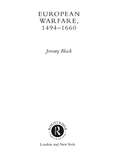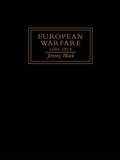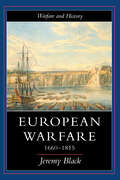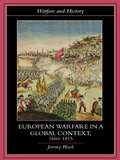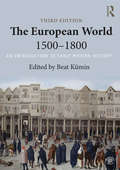- Table View
- List View
The European Union Since 1945
by Alasdair BlairThe European Union faces a crossroads in the twenty-first century. While there is evidence of declining enthusiasm for European integration, the EU plays an increasingly vital role in tackling problems that can no longer be dealt with at member state level. In recent years, the EU has developed a stronger foreign, security and defence policy, and has had to face up to the challenges of tackling organised crime, human trafficking and drug smuggling. In this fully updated new edition, Alasdair Blair examines the economic, political, social and personal factors that have shaped the process of European integration from the end of the Second World War until the Lisbon Treaty in 2009. Written in a clear and jargon-free style, the book explores: The context of European integration and expansion The relations between the European Union and its member states The institutional evolution of the European Union Methods of decision-making Key policies of the European Union The future direction of the European Union Comprehensive and accessible, this book is an essential guide to understanding the relevance of the European Union in the twenty-first century.
The European Union Since 1945
by Alasdair BlairThe European Union faces a crossroads in the twenty-first century. While there is evidence of declining enthusiasm for European integration, the EU plays an increasingly vital role in tackling problems that can no longer be dealt with at member state level. In recent years, the EU has developed a stronger foreign, security and defence policy, and has had to face up to the challenges of tackling organised crime, human trafficking and drug smuggling. In this fully updated new edition, Alasdair Blair examines the economic, political, social and personal factors that have shaped the process of European integration from the end of the Second World War until the Lisbon Treaty in 2009. Written in a clear and jargon-free style, the book explores: The context of European integration and expansion The relations between the European Union and its member states The institutional evolution of the European Union Methods of decision-making Key policies of the European Union The future direction of the European Union Comprehensive and accessible, this book is an essential guide to understanding the relevance of the European Union in the twenty-first century.
The European Union's Mediterranean Policy: A New Institutionalist Perspective
by K. KnioBy analysing case studies through the lens of new constructivist Institutionalist perspective, this book sheds new light on the failure of EU policies in the Mediterranean. It suggests that these failures are the result of problems at the very heart of EU policy-making which clearly privilege economic concerns over social concerns.
European Warfare, 1494-1660 (Warfare and History)
by Jeremy BlackThe onset of the Italian Wars in 1494, subsequently seen as the onset of 'modern warfare', provides the starting point for this impressive survey of European Warfare in early modern Europe. Huge developments in the logistics of war combined with exploration and expansion meant interaction with extra-European forms of military might. Jeremy Black looks at technological aspects of war as well social and political developments and effects during this key period of military history. This sharp and compact analysis contextualises European developments and as establishes the global significance of events in Europe.
European Warfare, 1494-1660 (Warfare and History)
by Jeremy BlackThe onset of the Italian Wars in 1494, subsequently seen as the onset of 'modern warfare', provides the starting point for this impressive survey of European Warfare in early modern Europe. Huge developments in the logistics of war combined with exploration and expansion meant interaction with extra-European forms of military might. Jeremy Black looks at technological aspects of war as well social and political developments and effects during this key period of military history. This sharp and compact analysis contextualises European developments and as establishes the global significance of events in Europe.
European Warfare, 1660-1815 (Warfare And History Ser.)
by Jeremy BlackThis is a history of warfare, wars and the armed forces of Europe from the military revolution of the mid-17th century to the Napoleonic wars.; This book is intended for broad-based undergrad courses on 18th century Europe/Britain and the Ancien Regime. 2nd and 3rd year thematic courses on warfare in the modern period, and students of war studies.
European Warfare, 1660-1815
by Jeremy BlackThis is a history of warfare, wars and the armed forces of Europe from the military revolution of the mid-17th century to the Napoleonic wars.; This book is intended for broad-based undergrad courses on 18th century Europe/Britain and the Ancien Regime. 2nd and 3rd year thematic courses on warfare in the modern period, and students of war studies.
European Warfare, 1660-1815 (Warfare And History Ser.)
by Professor Jeremy Black Jeremy BlackThis is a history of warfare, wars and the armed forces of Europe from the military revolution of the mid-17th century to the Napoleonic wars.; This book is intended for broad-based undergrad courses on 18th century Europe/Britain and the Ancien Regime. 2nd and 3rd year thematic courses on warfare in the modern period, and students of war studies.
European Warfare, 1660-1815
by Professor Jeremy Black Jeremy BlackThis is a history of warfare, wars and the armed forces of Europe from the military revolution of the mid-17th century to the Napoleonic wars.; This book is intended for broad-based undergrad courses on 18th century Europe/Britain and the Ancien Regime. 2nd and 3rd year thematic courses on warfare in the modern period, and students of war studies.
European Warfare 1815-2000 (Problems in Focus)
by Jeremy BlackIn this up-to-date account of European warfare since 1815, important treatments of major conflicts - especially World Wars I and II - are combined with insightful analyses of military developments and of their wider political and social contexts. European imperial warfare also receives due attention. European Warfare 1815-2000 recognises war as a topic of major importance in understanding the development of the modern world, particularly Europe. The contributors, all leading experts in their fields, are open to theoretical developments in the subject, but also understand the difficulty of 'fitting' war to any abstract model. Ranging up to the present, this is an original and fascinating volume.
European Warfare in a Global Context, 1660-1815 (Warfare and History)
by Jeremy BlackThis original book presents a global approach to eighteenth century warfare. Emphasis is placed on the importance of conflict in the period and the capacity for decisiveness in impact and development in method. Through this Jeremy Black extends the view beyond land to naval conflict. European Warfare in a Global Context offers a comparative approach, in the sense of considering Western developments alongside those elsewhere, furthermore it puts emphasis on conflict between Western and non-western powers. This approach necessarily reconsiders developments within the West, but also offers a shift in emphasis from standard narrative of the latter. This book is the ideal study of warfare for all students.
European Warfare in a Global Context, 1660-1815 (Warfare and History)
by Jeremy BlackThis original book presents a global approach to eighteenth century warfare. Emphasis is placed on the importance of conflict in the period and the capacity for decisiveness in impact and development in method. Through this Jeremy Black extends the view beyond land to naval conflict. European Warfare in a Global Context offers a comparative approach, in the sense of considering Western developments alongside those elsewhere, furthermore it puts emphasis on conflict between Western and non-western powers. This approach necessarily reconsiders developments within the West, but also offers a shift in emphasis from standard narrative of the latter. This book is the ideal study of warfare for all students.
The European Wars of Religion: An Interdisciplinary Reassessment of Sources, Interpretations, and Myths
by Wolfgang Palaver Harriet Rudolph Dietmar RegensburgerIn recent years religion has resurfaced amongst academics, in many ways replacing class as the key to understanding Europe's historical development. This has resulted in an explosion of studies revisiting issues of religious change, confessional violence and holy war during the early modern period. But the interpretation of the European wars of religion still remains largely defined by national boundaries, tied to specific processes of state building as well as nation building. In order to more thoroughly interrogate these concepts and assumptions, this volume focusses on terms repeatedly used and misused in public debates such as "religious violence" and "holy warfare" within the context of military conflicts commonly labelled "religious wars". The chapters not only focus on the role of religion, but also on the emerging state as a driver of the escalation of violence in the so-called age of religious war. By using different methodological and theoretical approaches historians, philosophers, and theologians engage in an interdisciplinary debate that contributes to a better understanding of the religio-political situation of early modern Europe and the interpretation of violent conflicts interpreted as religious conflicts today. By adopting a multi-disciplinary approach, new and innovative perspectives are opened up that question if in fact religion was a primary driving force behind these conflicts.
The European Wars of Religion: An Interdisciplinary Reassessment of Sources, Interpretations, and Myths
by Wolfgang Palaver Harriet Rudolph Dietmar RegensburgerIn recent years religion has resurfaced amongst academics, in many ways replacing class as the key to understanding Europe's historical development. This has resulted in an explosion of studies revisiting issues of religious change, confessional violence and holy war during the early modern period. But the interpretation of the European wars of religion still remains largely defined by national boundaries, tied to specific processes of state building as well as nation building. In order to more thoroughly interrogate these concepts and assumptions, this volume focusses on terms repeatedly used and misused in public debates such as "religious violence" and "holy warfare" within the context of military conflicts commonly labelled "religious wars". The chapters not only focus on the role of religion, but also on the emerging state as a driver of the escalation of violence in the so-called age of religious war. By using different methodological and theoretical approaches historians, philosophers, and theologians engage in an interdisciplinary debate that contributes to a better understanding of the religio-political situation of early modern Europe and the interpretation of violent conflicts interpreted as religious conflicts today. By adopting a multi-disciplinary approach, new and innovative perspectives are opened up that question if in fact religion was a primary driving force behind these conflicts.
The European Witch-Hunt
by Julian GoodareThe European Witch-Hunt seeks to explain why thousands of people, mostly lower-class women, were deliberately tortured and killed in the name of religion and morality during three centuries of intermittent witch-hunting throughout Europe and North America. Combining perspectives from history, sociology, psychology and other disciplines, this book provides a comprehensive account of witch-hunting in early modern Europe. Julian Goodare sets out an original interpretation of witch-hunting as an episode of ideologically-driven persecution by the ‘godly state’ in the era of the Reformation and Counter-Reformation. Full weight is also given to the context of village social relationships, and there is a detailed analysis of gender issues. Witch-hunting was a legal operation, and the courts’ rationale for interrogation under torture is explained. Panicking local elites, rather than central governments, were at the forefront of witch-hunting. Further chapters explore folk beliefs about legendary witches, and intellectuals’ beliefs about a secret conspiracy of witches in league with the Devil. Witch-hunting eventually declined when the ideological pressure to combat the Devil’s allies slackened. A final chapter sets witch-hunting in the context of other episodes of modern persecution. This book is the ideal resource for students exploring the history of witch-hunting. Its level of detail and use of social theory also make it important for scholars and researchers.
The European Witch-Hunt
by Julian GoodareThe European Witch-Hunt seeks to explain why thousands of people, mostly lower-class women, were deliberately tortured and killed in the name of religion and morality during three centuries of intermittent witch-hunting throughout Europe and North America. Combining perspectives from history, sociology, psychology and other disciplines, this book provides a comprehensive account of witch-hunting in early modern Europe. Julian Goodare sets out an original interpretation of witch-hunting as an episode of ideologically-driven persecution by the ‘godly state’ in the era of the Reformation and Counter-Reformation. Full weight is also given to the context of village social relationships, and there is a detailed analysis of gender issues. Witch-hunting was a legal operation, and the courts’ rationale for interrogation under torture is explained. Panicking local elites, rather than central governments, were at the forefront of witch-hunting. Further chapters explore folk beliefs about legendary witches, and intellectuals’ beliefs about a secret conspiracy of witches in league with the Devil. Witch-hunting eventually declined when the ideological pressure to combat the Devil’s allies slackened. A final chapter sets witch-hunting in the context of other episodes of modern persecution. This book is the ideal resource for students exploring the history of witch-hunting. Its level of detail and use of social theory also make it important for scholars and researchers.
European Women in Persian Houses: Western Images in Safavid and Qajar Iran
by Parviz TanavoliDuring the course of the 19th century, a relatively modern medium entered the private space of Iranian houses of the wealthy and became a popular feature of interior design in Persia. This was print media - lithographed images on paper and postcards - and their subject was European women. These idealised images adorned houses across the country throughout the Qajar period and this trend was particularly fashionable in Isfahan and mural decorations at the entrance gate of the Qaysarieh bazaar. The interest in images of Western women was an unusual bi-product of Iran's early political and cultural encounters with the West. In a world where women were rarely seen in public and, even then, were heavily veiled, the notion of European women dressed in - by Iranian standards - elegant and revealing clothing must have sparked much curiosity and some titillation among well-to-do merchants and aristocrats who felt the need to create some association, however remote, with these alien creatures. The introduction of such images began during the Safavid era in the 17th century with frescoes in royal palaces.This spread to other manifestations in the form of tile work and porcelain in the Qajar era, which became a testament to the popularity of this visual phenomenon among Iran's urban elite in the 19th and early 20th century. Parviz Tanavoli, the prominent Iranian artist and sculptor, here brings together the definitive collection of these unique images. European Women in Persian Houses will be essential for collectors and enthusiasts interested in Iranian art, culture and social history.
The European World: An Introduction To Early Modern History (PDF)
by Beat KüminThe European World 1500-1800 provides a concise and authoritative textbook for the centuries between the Renaissance and the French Revolution. It presents early modern Europe not as a mere transitional phase, but a dynamic period worth studying in its own right. Written by an experienced team of specialists, and derived from a perennially successful undergraduate course, it offers a student-friendly introduction to all major themes and processes of early modern history. Structured in four parts dealing with socio-economic, religious, cultural and political issues, it adopts a deliberately broad geographical perspective: Western and Central Europe receive particular attention, but dedicated chapters also explore the wider global context. For this thoroughly revised and improved second edition, the authors have added three new chapters on Politics and Government, Impact of War' and Revolution Specially designed to assist learning, The European World 1500-1800 features: state-of-the-art surveys of key topics written by an international team of historians suggestions for seminar discussion and further reading extracts from primary sources and generous illustrations, including maps a glossary of key terms and concepts a chronology of major events a full index of persons, places and subjects a fully-featured companion website, enhanced for this new edition The European World 1500-1800 will be essential reading for all students embarking on the discovery of the early modern period. "
The European World 1500-1800: An Introduction To Early Modern History
by Beat KüminThe European World 1500-1800 provides a concise and authoritative textbook for the centuries between the Renaissance and the French Revolution. It presents early modern Europe not as a mere transitional phase, but a dynamic period worth studying in its own right. Written by an experienced team of specialists, and derived from a perennially successful undergraduate course, it offers a student-friendly introduction to all major themes and processes of early modern history. Structured in four parts dealing with socio-economic, religious, cultural and political issues, it adopts a deliberately broad geographical perspective: Western and Central Europe receive particular attention, but dedicated chapters also explore the wider global context. For this thoroughly revised and improved second edition, the authors have added three new chapters on 'Politics and Government', 'Impact of War' and 'Revolution' Specially designed to assist learning, The European World 1500-1800 features: state-of-the-art surveys of key topics written by an international team of historians suggestions for seminar discussion and further reading extracts from primary sources and generous illustrations, including maps a glossary of key terms and concepts a chronology of major events a full index of persons, places and subjects a fully-featured companion website, enhanced for this new edition The European World 1500-1800 will be essential reading for all students embarking on the discovery of the early modern period. 9780415628631 9780415628648 9781315863115
The European World 1500-1800: An Introduction To Early Modern History (PDF)
by Beat KüminThe European World 1500-1800 provides a concise and authoritative textbook for the centuries between the Renaissance and the French Revolution. It presents early modern Europe not as a mere transitional phase, but a dynamic period worth studying in its own right. Written by an experienced team of specialists, and derived from a perennially successful undergraduate course, it offers a student-friendly introduction to all major themes and processes of early modern history. Structured in four parts dealing with socio-economic, religious, cultural and political issues, it adopts a deliberately broad geographical perspective: Western and Central Europe receive particular attention, but dedicated chapters also explore the wider global context. For this thoroughly revised and improved second edition, the authors have added three new chapters on 'Politics and Government', 'Impact of War' and 'Revolution' Specially designed to assist learning, The European World 1500-1800 features: state-of-the-art surveys of key topics written by an international team of historians suggestions for seminar discussion and further reading extracts from primary sources and generous illustrations, including maps a glossary of key terms and concepts a chronology of major events a full index of persons, places and subjects a fully-featured companion website, enhanced for this new edition The European World 1500-1800 will be essential reading for all students embarking on the discovery of the early modern period. 9780415628631 9780415628648 9781315863115
The European World 1500-1800: An Introduction To Early Modern History (PDF)
by Beat KüminThe European World 1500 1800 provides a concise and authoritative textbook for the centuries between the Renaissance and the French Revolution. It presents early modern Europe not as a mere transition phase, but a dynamic period worth studying in its own right. Written by an experienced team of specialists, associated with a university module of the same name, it offers a student-friendly introduction to all major themes and processes of early modern history. Structured in four parts dealing with socio-economic, religious, cultural and political issues, it adopts a broad geographical perspective: Western and Central Europe receive particular attention, but dedicated chapters also explore the wider global context. Thematic priorities include social structures, Reformation change, expanding cultural horizons and the emergence of the modern state. Specially designed to assist learning, The European World 1500 1800 features: up-to-date surveys of key topics written by an international team of historians suggestions for seminar discussion and further reading extracts from primary sources and vivid illustrations, including maps a glossary of key terms and concepts a chronology of major events a full index of persons, places and subjects a fully-featured companion website accessible at www. routledge. com/textbooks/9780415432535. The European World 1500 1800 will be essential reading for all students embarking on the discovery of the early modern period. "
The European World 1500-1800: An Introduction To Early Modern History (PDF)
by Beat KüminThe European World 1500 1800 provides a concise and authoritative textbook for the centuries between the Renaissance and the French Revolution. It presents early modern Europe not as a mere transition phase, but a dynamic period worth studying in its own right. Written by an experienced team of specialists, associated with a university module of the same name, it offers a student-friendly introduction to all major themes and processes of early modern history. Structured in four parts dealing with socio-economic, religious, cultural and political issues, it adopts a broad geographical perspective: Western and Central Europe receive particular attention, but dedicated chapters also explore the wider global context. Thematic priorities include social structures, Reformation change, expanding cultural horizons and the emergence of the modern state. Specially designed to assist learning, The European World 1500 1800 features: up-to-date surveys of key topics written by an international team of historians suggestions for seminar discussion and further reading extracts from primary sources and vivid illustrations, including maps a glossary of key terms and concepts a chronology of major events a full index of persons, places and subjects a fully-featured companion website accessible at www. routledge. com/textbooks/9780415432535. The European World 1500 1800 will be essential reading for all students embarking on the discovery of the early modern period. "
The European World 1500–1800
by Beat KüminThe European World 1500-1800 provides a concise and authoritative textbook for the centuries between the Renaissance and the French Revolution. It presents early modern Europe not as a mere transitional phase, but a dynamic period worth studying in its own right. Written by an experienced team of specialists, and derived from a perennially successful undergraduate course, it offers a student-friendly introduction to all major themes and processes of early modern history. Structured in four parts dealing with socio-economic, religious, cultural and political issues, it adopts a deliberately broad geographical perspective: Western and Central Europe receive particular attention, but dedicated chapters also explore the wider global context. For this thoroughly revised and improved second edition, the authors have added three new chapters on ‘Politics and Government’, ‘Impact of War' and ‘Revolution’ Specially designed to assist learning.
The European World 1500–1800: An Introduction to Early Modern History
by Beat KüminThe European World 1500-1800 provides a concise and authoritative textbook for the centuries between the Renaissance and the French Revolution. It presents early modern Europe not as a mere transition phase, but a dynamic period worth studying in its own right. Written by an experienced team of specialists, and derived from a successful undergraduate course, it offers a student-friendly introduction to all major themes and processes of early modern history. This third edition features greatly expanded coverage of ‘The Wider World’, with added chapters on relations with the Ottoman empire, European settlement overseas and the global exchange of goods. Other new content includes an overview of early modern medicine and comprehensive timelines for each of the thematic parts. Specially designed to assist learning, The European World 1500-1800 features: expert surveys of key topics written by an international group of historians suggestions for seminar discussion and further reading extracts from primary sources and generous illustrations, including maps a glossary of key terms and concepts a full index of persons, places and subjects and a much enhanced companion website, offering colour images, direct access to primary materials, and interactive features which highlight key events and locations discussed in the volume. The European World 1500-1800 will be essential reading for all students embarking on the discovery of the early modern period.
The European World 1500–1800: An Introduction to Early Modern History
by Beat KüminThe European World 1500-1800 provides a concise and authoritative textbook for the centuries between the Renaissance and the French Revolution. It presents early modern Europe not as a mere transition phase, but a dynamic period worth studying in its own right. Written by an experienced team of specialists, and derived from a successful undergraduate course, it offers a student-friendly introduction to all major themes and processes of early modern history. This third edition features greatly expanded coverage of ‘The Wider World’, with added chapters on relations with the Ottoman empire, European settlement overseas and the global exchange of goods. Other new content includes an overview of early modern medicine and comprehensive timelines for each of the thematic parts. Specially designed to assist learning, The European World 1500-1800 features: expert surveys of key topics written by an international group of historians suggestions for seminar discussion and further reading extracts from primary sources and generous illustrations, including maps a glossary of key terms and concepts a full index of persons, places and subjects and a much enhanced companion website, offering colour images, direct access to primary materials, and interactive features which highlight key events and locations discussed in the volume. The European World 1500-1800 will be essential reading for all students embarking on the discovery of the early modern period.


